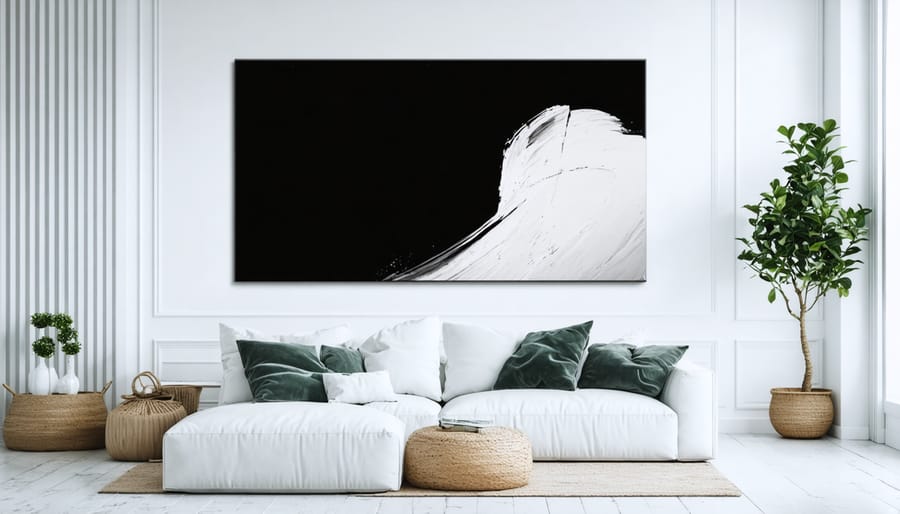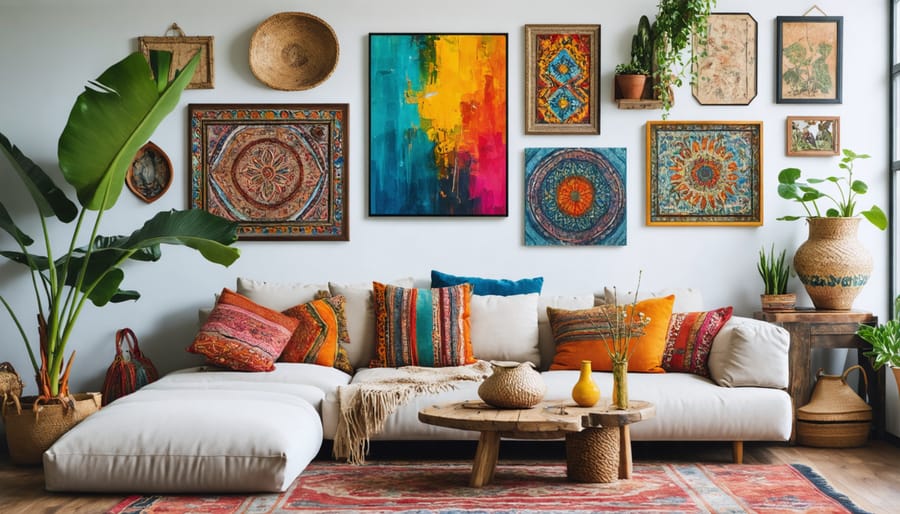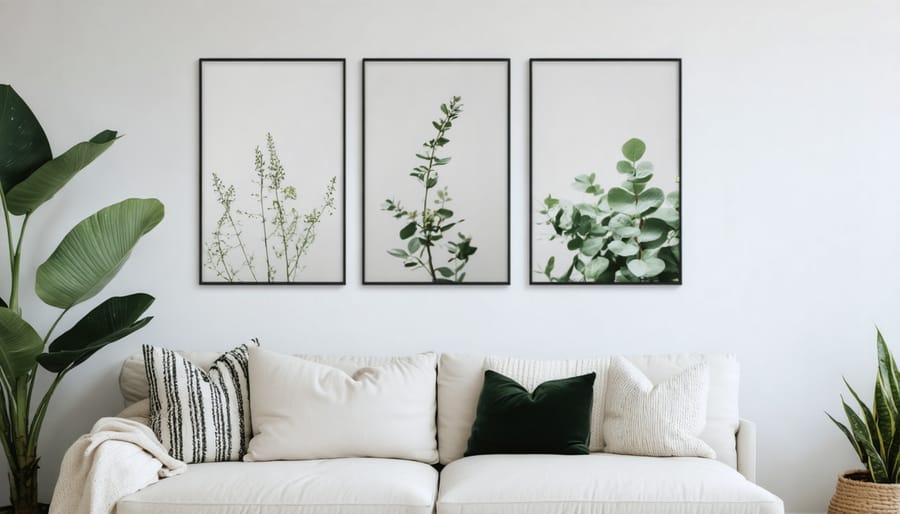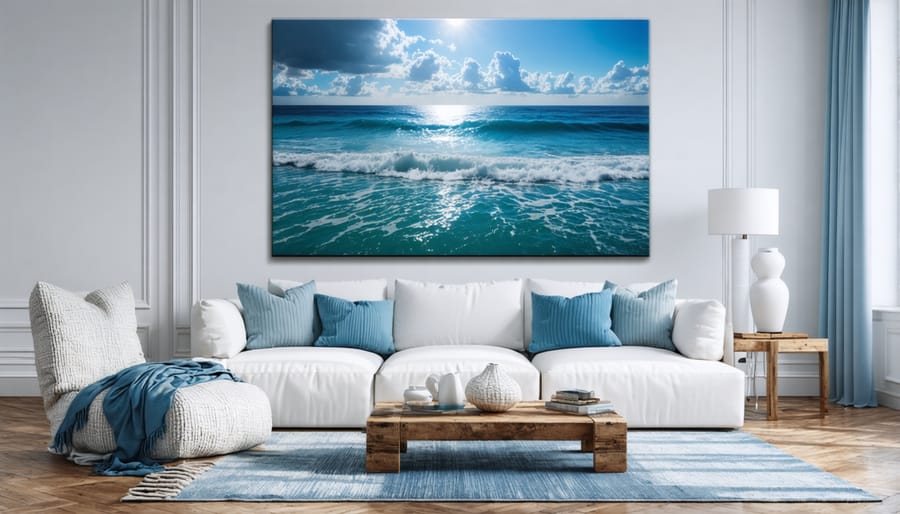Transform your living space into a personalized sanctuary by mastering the seven fundamental interior design styles that shape modern homes. From the clean lines of Scandinavian minimalism to the bold patterns of Bohemian chic, each design approach offers unique ways to express your personality and create the perfect atmosphere. Whether you’re planning a complete home makeover or simply seeking inspiration for your next room refresh, understanding these distinct styles will empower you to make confident design choices that blend aesthetics with functionality.
In this comprehensive guide, we’ll explore the essential elements, color palettes, and signature pieces that define each interior design style. You’ll discover how to identify your preferred aesthetic, mix different approaches seamlessly, and incorporate artwork that complements your chosen style. Plus, we’ll share expert tips on selecting furniture, lighting, and accessories that bring your vision to life while staying true to your budget and lifestyle needs.
Get ready to unlock the secrets of professional interior designers and learn how to create spaces that don’t just look stunning but feel authentically yours. Let’s dive into the world of interior design styles that are shaping homes in 2024 and beyond.
Contemporary Minimalism

Key Features
Contemporary minimalist art integration focuses on creating impact through carefully selected pieces that complement clean lines and uncluttered spaces. The key is choosing statement artwork that speaks volumes without overwhelming the room. Look for pieces with bold geometric shapes, monochromatic color schemes, or simple abstract designs that maintain the minimalist aesthetic while adding visual interest.
Consider large-scale canvas prints or metal wall sculptures that serve as focal points against neutral walls. These pieces should follow the “less is more” principle, allowing negative space to enhance their impact. Photography featuring clean compositions or black-and-white prints work particularly well in minimalist settings.
When it comes to placement, opt for single dramatic pieces rather than gallery walls. Float artwork at eye level, leaving plenty of breathing room around each piece. For three-dimensional art, incorporate sleek sculptures on simple pedestals or minimal floating shelves. The goal is to create moments of artistic expression that enhance the space without disrupting its peaceful, uncluttered atmosphere.
Remember that lighting plays a crucial role – use focused LED spots or track lighting to highlight your chosen pieces while maintaining the clean, modern feel of your space.
Art Selection Tips
Selecting the right artwork for minimalist spaces requires a thoughtful approach that balances visual impact with simplicity. Start by choosing pieces that feature clean lines and uncomplicated compositions – a single bold photograph or an abstract piece with limited color palette works wonderfully in minimalist settings.
Consider scale carefully; one large statement piece often works better than multiple small artworks, maintaining the uncluttered aesthetic essential to minimalist design. Black and white photography or monochromatic pieces are particularly effective, as they complement the typically neutral color schemes of minimalist spaces.
When it comes to framing, opt for simple, slim frames in black, white, or natural wood tones. Alternatively, canvas prints without frames can create an even more streamlined look. Position artwork with plenty of breathing space around it – this allows each piece to make its statement without competing for attention.
Remember that in minimalist design, negative space is just as important as the art itself. Don’t feel pressured to fill every wall; sometimes, a single well-chosen piece in a room is all you need to create maximum impact while maintaining minimalist principles.
Eclectic Bohemian
Gallery Wall Creation
Transform your wall into a stunning visual story by creating an art gallery atmosphere that reflects your personality. Start by gathering a diverse collection of pieces – from framed photographs and paintings to mirrors, tapestries, and dimensional objects. The key to a captivating gallery wall lies in mixing different sizes, shapes, and textures while maintaining a cohesive theme through color palette or subject matter.
Begin by laying out your arrangement on the floor, experimenting with different configurations until you find the perfect balance. A helpful tip is to use kraft paper templates on the wall to visualize the final layout before committing to nail holes. Keep larger pieces as anchor points, typically centered or slightly off-center, and build outward with smaller items.
For professional-looking results, maintain consistent spacing between pieces (typically 2-3 inches) and ensure frames are hung at eye level. Don’t be afraid to mix frame styles – combining modern metallic frames with vintage wooden ones adds depth and character. Remember, your gallery wall should evolve over time, allowing you to add new pieces that speak to your journey and style.

Color Coordination
Balancing colors in bohemian spaces is like conducting a visual symphony where seemingly disparate elements come together harmoniously. Start with a neutral base – think warm whites or soft beiges – to ground your space and prevent visual overwhelm. Layer in your primary colors through larger pieces like rugs or curtains, then add secondary hues through furniture and medium-sized art pieces.
The key to successful color coordination in bohemian design lies in creating intentional color stories throughout the room. Choose two to three dominant colors and weave them throughout your space using different shades and intensities. For example, if you’re working with deep purple, terra cotta, and gold, use these colors in varying proportions – 60% for your primary color, 30% for your secondary, and 10% for accents.
Don’t shy away from mixing patterns and textures, but maintain cohesion by repeating colors across different elements. Consider the visual weight of each piece and create balance through strategic placement. Remember, bohemian spaces thrive on controlled chaos – while the overall effect might appear spontaneous, successful color coordination requires thoughtful planning and careful curation.
Industrial Modern
Urban Art Selection
Urban art can transform an industrial space from stark to stunning, bringing personality and edge to your interior. When selecting urban art pieces, consider large-scale graffiti-inspired canvases or street photography that captures city life in all its raw beauty. Look for pieces that incorporate bold colors, geometric patterns, or abstract designs that complement the industrial elements of your space.
Original street art prints, urban photography, or commissioned murals work exceptionally well in these settings. Consider pieces that feature architectural elements, city skylines, or abstract interpretations of urban landscapes. Metal sculptures or installations using reclaimed materials can add an authentic industrial touch while serving as conversation starters.
For a cohesive look, choose artwork that picks up colors from existing elements in your space, like exposed brick or metal fixtures. Don’t be afraid to mix different mediums – combining photography with painted pieces or digital art can create an engaging gallery wall. Remember to scale your art appropriately; industrial spaces often have high ceilings and large walls that can handle oversized pieces.
Consider positioning art pieces near architectural features like exposed pipes or beams to create intentional design moments that celebrate rather than hide industrial elements.
Installation Methods
Industrial spaces offer unique opportunities for creative art displays that complement their raw, architectural elements. Try mounting artwork on exposed brick walls using industrial-style brackets or pipes for an authentic look. Cable wire systems are perfect for hanging multiple pieces in a gallery-style arrangement, allowing for easy updates and rearrangement.
Consider using reclaimed materials like wooden pallets or metal scaffolding boards as unconventional frames or backing for artwork. Metal grid panels can serve as versatile display surfaces, perfect for clipping or hanging smaller pieces. For larger installations, suspend art from exposed ceiling beams using steel cables or chains, creating a dynamic floating effect.
Make use of existing industrial features by incorporating artwork into metal shelving units or displaying pieces on concrete ledges. Rolling metal carts can become mobile art displays, while vintage factory equipment can be repurposed as unique art stands. Remember to balance the industrial elements with proper lighting – track lighting or adjustable wall-mounted fixtures can highlight your artwork while maintaining the industrial aesthetic.
For a cohesive look, group similar pieces together and vary the heights and sizes of your displays to create visual interest without overwhelming the space.
Classic Traditional
Traditional Art Placement
When it comes to displaying traditional artwork, proper placement is crucial for creating a harmonious interior space. The classic rule of hanging art at eye level (approximately 57-60 inches from the floor to the center of the piece) remains a reliable guideline. In living rooms, position larger pieces above sofas with 6-8 inches of breathing space between the furniture and artwork.
For gallery walls, maintain consistent spacing between pieces (typically 2-3 inches) and balance the composition by mixing different sizes and orientations. Consider incorporating biophilic design elements alongside traditional art to create dynamic visual interest.
In dining rooms, hang artwork low enough to be enjoyed while seated, and in hallways, create visual flow by maintaining uniform height for all pieces. When placing sculptures or three-dimensional art, ensure proper lighting and allow viewers to appreciate the piece from multiple angles. Remember to protect valuable artwork from direct sunlight and consider using museum-grade glass for important pieces to prevent UV damage while maintaining visual clarity.
Framing Choices
Choosing the right frame can make or break your artwork’s impact in a room. When selecting frames for traditional art pieces, consider both the artwork’s style and your room’s overall design scheme. For classic oil paintings, ornate gold or silver frames often work beautifully, especially in formal spaces. However, don’t feel bound by convention – sometimes a simple black frame can make traditional art feel more contemporary.
Match your frame width to your artwork’s size; larger pieces generally need wider frames to maintain visual balance. Consider matting as well – a neutral-colored mat can create breathing space between the art and frame, making the piece more visually appealing. For vintage prints or photographs, distressed wooden frames can add character while complementing traditional décor.
Remember to account for your room’s lighting when selecting frame finishes. Metallic frames can reflect light and add sparkle to darker spaces, while matte finishes work well in brightly lit rooms. When grouping multiple pieces, you don’t need identical frames, but they should share some common elements – whether it’s color, material, or style – to create a cohesive look.

Scandinavian
Nature-Inspired Elements
Nature-inspired artwork brings the calming essence of the outdoors into your living space, creating a seamless connection between interior and exterior environments. Consider incorporating pieces that feature botanical illustrations, landscape photography, or abstract interpretations of natural elements. Pressed flower art, driftwood sculptures, and watercolor paintings of forest scenes can add organic texture and visual interest to your walls.
When selecting nature-themed artwork, focus on pieces that reflect your local environment or favorite natural settings. Mountain landscapes work beautifully in rustic homes, while coastal scenes complement beach-inspired interiors. Don’t forget about the power of natural materials in your frames – opt for bamboo, reclaimed wood, or other sustainable materials to enhance the organic feel.
Layer your nature-inspired artwork with actual natural elements like potted plants, stone collections, or dried botanicals to create a cohesive look. The key is to maintain a balance – mix different sizes and mediums while keeping a consistent color palette that echoes the natural world. This approach helps create a peaceful, grounding atmosphere that connects your indoor space with the beauty of nature.
Light and Space
Light plays a crucial role in showcasing art and creating atmosphere in your home. The key is understanding how natural and artificial lighting work together to enhance your space. Start by evaluating your room’s natural light sources and identifying peak lighting hours throughout the day. This knowledge will help you with strategic lighting placement for both your art and overall room design.
For optimal art display, position pieces where they won’t receive direct sunlight, which can cause fading and damage. Instead, use ambient lighting to create depth and drama. Consider installing picture lights or track lighting to highlight specific artwork, creating focal points that draw the eye. This approach not only protects your art but also enhances its visual impact.
The relationship between light and space also affects color harmony in design. Light colors reflect more light and can make spaces feel larger, while darker tones absorb light and create cozier atmospheres. Use this principle when selecting both artwork and wall colors to achieve your desired spatial effect.
Mid-Century Modern
Geometric Art Selection
Geometric art adds a striking visual element to any interior, combining bold shapes with mathematical precision. When selecting geometric pieces, start by considering your room’s existing color palette and scale. Large, statement pieces work beautifully in spacious areas like living rooms, while smaller geometric prints can create intimate focal points in hallways or home offices.
Look for pieces that incorporate complementary shapes – mixing circles with squares, or triangles with hexagons can create dynamic visual interest. Pay attention to the balance between busy and calm areas within the artwork; too many competing patterns can overwhelm a space. Consider abstract pieces that use geometric elements subtly, such as those featuring repeated patterns or symmetrical designs.
For a cohesive look, choose artwork that echoes architectural elements in your space. If your room features angular furniture or lighting fixtures, select geometric art that mirrors these shapes. Don’t be afraid to experiment with different mediums – from metal wall sculptures to printed canvas works. The key is finding pieces that speak to your personal style while maintaining visual harmony with your overall design scheme.
Color Balance
Creating a harmonious balance between art and mid-century furniture is like conducting a visual symphony in your home. The key lies in understanding how colors interact and complement each other across your furniture pieces and artwork. Start by identifying the dominant colors in your mid-century furniture – typically warm woods, bold primary colors, or earthy tones – and use these as a foundation for your art selections.
When choosing artwork, look for pieces that either complement or thoughtfully contrast with your furniture. For instance, if you have a classic tan leather Eames lounge chair, consider artwork with warm oranges and browns to create cohesion, or opt for cool blues and greens for an eye-catching contrast. Remember that balance doesn’t mean everything needs to match perfectly.
For the best results, follow the 60-30-10 rule: use your dominant color in 60% of the space, a secondary color in 30%, and an accent color in 10%. This creates visual interest while maintaining harmony. Don’t be afraid to experiment with different combinations – sometimes the most striking spaces come from unexpected color pairings.
To maintain balance, consider the scale of both your furniture and artwork. Large pieces of furniture pair well with similarly sized artwork, while smaller furniture pieces can be enhanced by gallery walls or collections of smaller artworks.
Coastal Style

Maritime Art Selection
When selecting maritime art for your coastal-inspired space, start with pieces that capture the essence of seaside living without being too literal. Consider vintage nautical maps, which add both character and sophistication, or abstract seascapes that bring movement and color to your walls. Watercolor paintings of boats, lighthouses, and harbor scenes work particularly well in living rooms and studies.
For a subtle maritime touch, black and white photography of sailboats or coastal landscapes can create an elegant, timeless feel. Beach scenes work wonderfully in bedrooms and bathrooms, creating a calming atmosphere that echoes the tranquility of the ocean.
Keep your maritime art selection balanced by mixing different mediums. Pair a large statement piece, like a dramatic ocean photograph, with smaller complementary pieces such as framed shell collections or coral illustrations. When arranging your maritime artwork, create a gallery wall that tells a story, moving from deeper waters to shoreline scenes.
Remember to consider the color palette of your space – blues, whites, and sandy neutrals typically work best, but don’t shy away from adding pops of coral or sea glass green through your art choices.
Natural Elements
Natural elements bring the outdoors inside, creating a serene and grounding atmosphere in your living space. This design approach emphasizes the use of raw materials like wood, stone, bamboo, and rattan to establish a strong connection with nature. Think exposed wooden beams, stone accent walls, or a sleek marble countertop that adds both functionality and natural beauty.
To incorporate this style, start with a neutral color palette inspired by earth tones – warm browns, soft greens, and subtle grays. Layer your space with different textures through natural fiber rugs, woven baskets, and linen textiles. Live plants are essential elements, adding vitality and fresh energy while purifying the air.
Consider integrating water features like small indoor fountains or showcasing collections of rocks and minerals. Natural light plays a crucial role, so maximize window exposure and use sheer curtains to maintain the bright, airy feel. When selecting furniture, opt for pieces made from sustainable materials with organic shapes and minimal processing to maintain authenticity.
Remember, the key is balance – mix raw elements with modern amenities to create a space that’s both sophisticated and naturally inviting.
As we’ve explored these seven distinct interior design styles, it’s clear that art plays a vital role in bringing each aesthetic to life. Whether you’re drawn to the clean lines of modern design or the warmth of traditional spaces, thoughtful art integration can elevate your interior from good to extraordinary.
Remember that successful art placement isn’t just about following rules – it’s about creating harmony between your chosen design style and personal taste. Start by identifying your preferred aesthetic, then select artwork that complements both the style’s core principles and your individual preferences. Don’t be afraid to mix different art mediums, but maintain consistency in how you display them.
For best results, consider these final tips: Always test artwork placement before making holes in your walls, use proper lighting to enhance your pieces, and ensure your art is scaled appropriately for your space. Group similar pieces together for impact, but leave enough breathing room to appreciate each work individually.
Most importantly, let your space evolve naturally. Start with key pieces that speak to you and gradually build your collection over time. Your home should tell your story while staying true to your chosen design style. With these guidelines in mind, you’re well-equipped to create a cohesive, artfully designed space that reflects both your chosen aesthetic and personal style.
